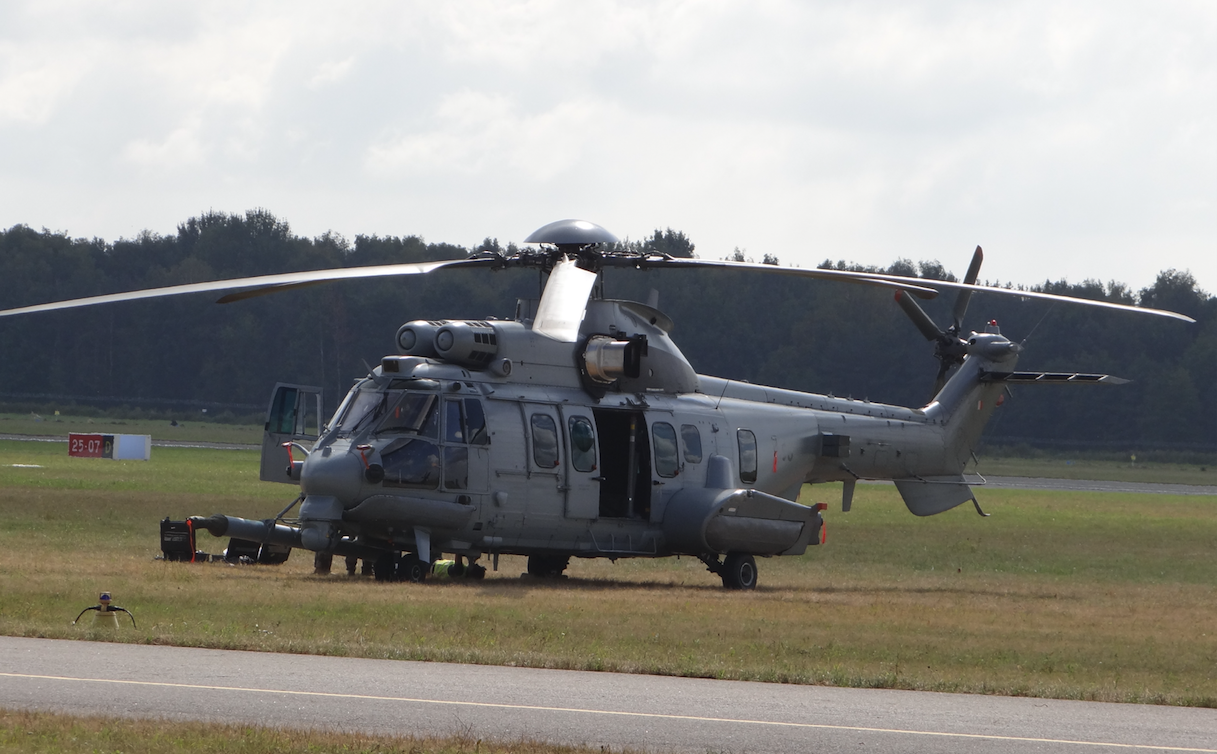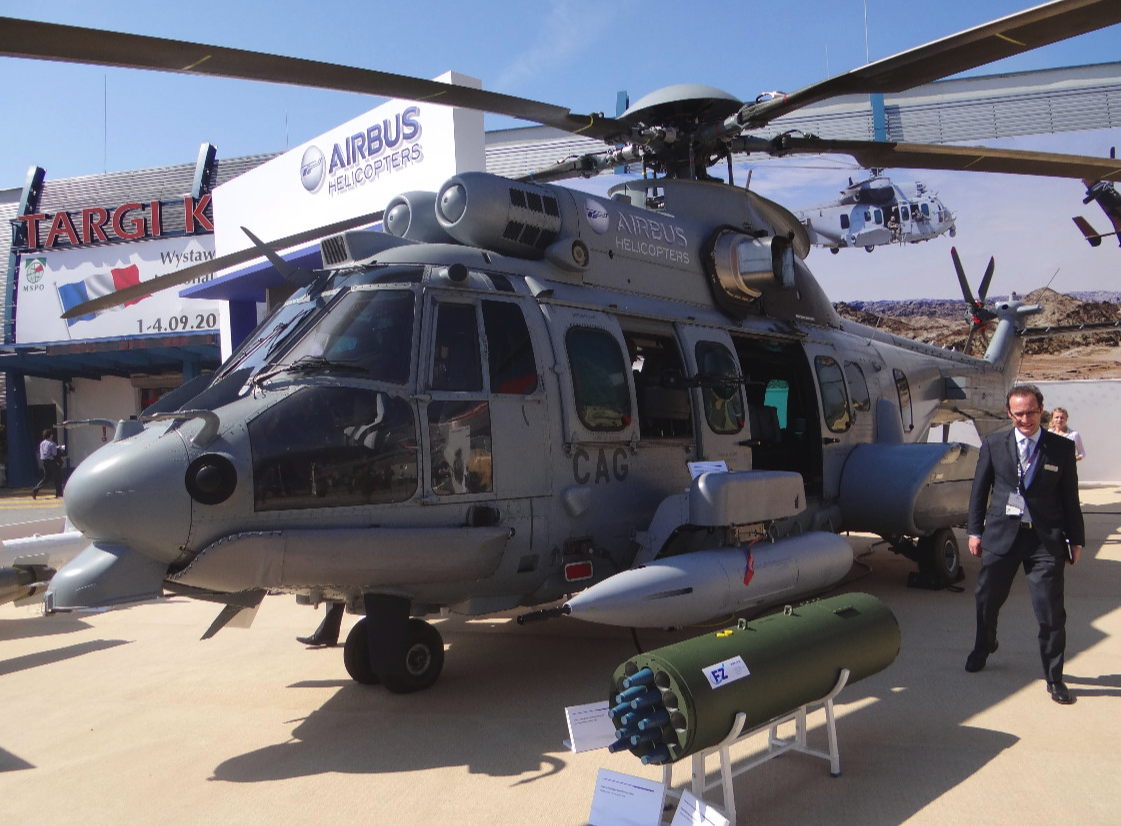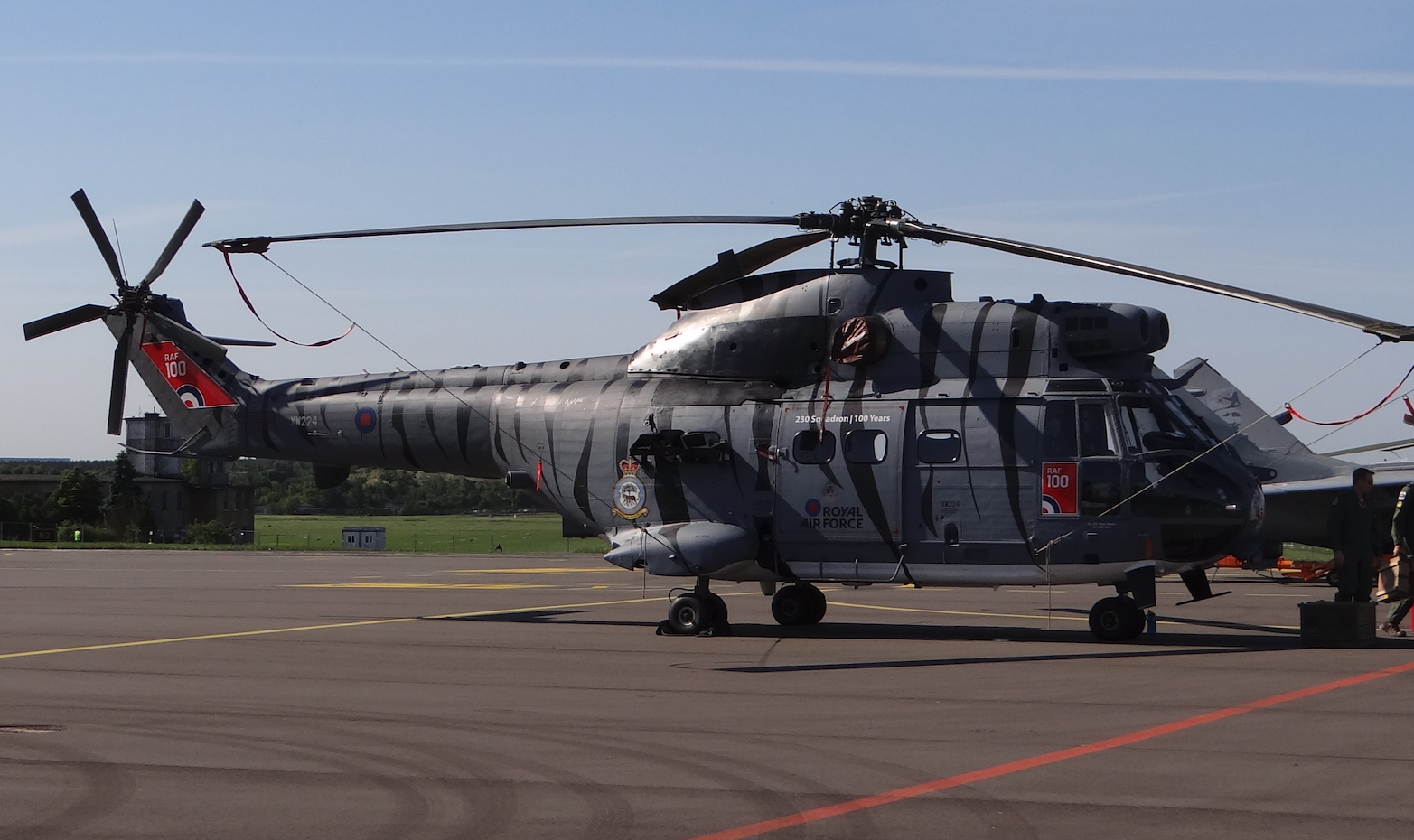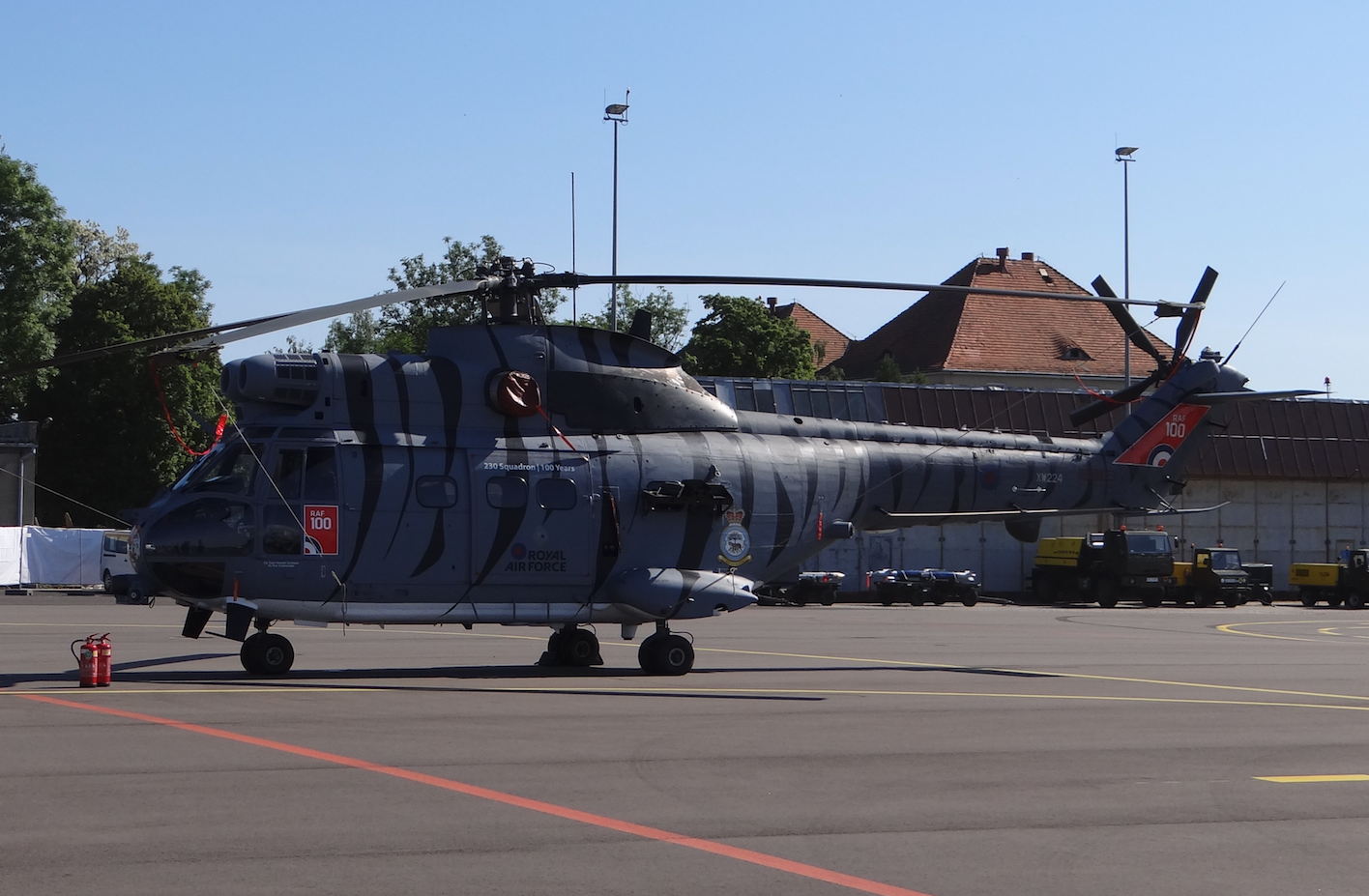Warszawa 2018-05-29
Airbus Helicopters H.225 Caracal.
319a Rozdział 2013 rok. Polska.
Historia.





Airbus Helicopters H.225M Caracal (zwany również Super Cougar), wcześniej nazywany Eurocopter EC.725 Caracal, to taktyczny wojskowy śmigłowiec transportowy dalekiego zasięgu opracowany z poprzedniej konstrukcji Eurocopter AS.532 do celów wojskowych.
Jest to dwusilnikowy śmigłowiec z dwoma pilotami na pokładzie i może pomieścić do 29 w pełni uzbrojonych żołnierzy, w zależności od konfiguracji wybranej przez klienta. Śmigłowiec jest używany do transportu żołnierzy, sprzętu wojskowego, ewakuacji po wypadkach oraz poszukiwań i akcji ratowniczych i jest podobny do cywilnego EC.225. Cywilny EC.225 służy do przewozu osób i towarów.
Program Caracal.
Nowy śmigłowiec został opracowany w celu spełnienia wymogu francuskich sił powietrznych na specjalistyczny śmigłowiec do operacji bojowych, poszukiwań i ratownictwa.
Model AS.532 A2 Cougar został przebadany i po szeroko zakrojonych próbach w latach 1996-1999, został nieprzyjęty do produkcji i służby. Wojsko zażądało poprawienia konstrukcji. Głównymi ulepszeniami pożądanymi przez Francuskie Siły Powietrzne były mocniejsze silniki, lepsze parametry lotu i zwiększona wytrzymałość bojowa. Firma Eurocopter zdecydował się na opracowanie bardziej ambitnej konstrukcji pochodzącej z AS.532 w celu zaspokojenia tych żądań.
Nowa konstrukcja została oznaczona EC.725. Śmigłowiec EC.725 początkowo nosił nazwę własną Cougar Mk II +. Najważniejsze cechy to pojemność zbiorników paliwa wynosząca 3750 litrów / 990 galonów, dająca śmigłowcowi czas lotu 5 godzin i 30 minut, plus zdolność tankowania w powietrzu. Wzmocniona została główna przekładnia. Zastosowano nowy 5-łopatowy wirnik główny, 4-osiowy autopilot, system naprowadzania dla awaryjnych sygnalizatorów lokalizacyjnych, montowanego opancerzenia i zintegrowanych zabezpieczeń. W nowym śmigłowcu zastosowano nowe wyposażenie misji i autonomiczną awionikę.
W dniu 27 listopada 2000 roku, pierwszy prototyp EC.725 wykonał swój pierwszy lot w Marignane. Marignane to miejscowość we Francji nad Morzem Śródziemnym. W dniu 15 stycznia 2001 roku, odbyła się pierwsza publiczna prezentacja nowego śmigłowca. Przy równoczesnym rozwoju zorientowanego na wojsko EC.725, firma Eurocopter opracowała również cywilny odpowiednik, który został oznaczony jako EC.225.
Francuskie siły powietrzne zamówiły początkowo sześć śmigłowców EC.725, do zadań Combat Search & Rescue. Koszt 15 milionów euro za egzemplarz. Pierwsza maszyna została dostarczona w lutym 2005 roku. Kolejne zlecenie na osiem egzemplarzy EC.725 zostało złożone dla francuskich sił zbrojnych w listopadzie 2002 roku. Śmigłowiec został zamówiony przez: Francja, Brazylia, Indonezja, Kazachstan, Kuwejt, Malezję, Singapur, Meksyk, Tajlandię i Indie. Operatorzy EC 725 (poza Francuskimi Siłami Powietrznymi i Marynarką Wojenną) obejmują Brazylijskie Siły Powietrzne, Marynarkę Wojenną, Armię i rząd, Kazachstan Sił Powietrznych, Siła Lotnicza Indonezji, Królewskie Saudyjskie Siły Powietrzne, Królewskie Siły Powietrzne Malezji i Meksykańskie Siły Powietrzne. Około 30 maszyn jest w użyciu.
Śmigłowiec H.225M był produkowany na dwóch oddzielnych liniach produkcyjnych we Francji i Brazylii.
Warianty modeli serii:
H.725 – Oznaczenie serii pod marką Airbus Helicopters.
EC.725 "Caracal" ("Super Cougar") – Oznaczenie serii podstawowej pod marką Eurocopter; śmigłowiec jest przeznaczony do transportu wojskowego.
EC.725 VIP – Transport VIP z miejscami do siedzenia dla maksymalnie 12 osób.
EC.725 MEDEVAC – Medyczny model ewakuacji z miejscem na 12 x nosze i 4 medyczne statywy.
EC.725 SAR – wariant wyszukiwania i ratowania wyposażony w odpowiedni sprzęt do ratowania osób.
W 2017 roku, francuskie ministerstwo obrony poinformowało, że uziemionych jest ponad 75 % śmigłowców typu Caracal. Dlaczego? Ich naprawa jest zbyt droga. W ciągu ostatnich czterech lat koszty ich naprawy wzrosły dwukrotnie.
Airbus Caracal dla Wojska Polskiego.
Wiosną 2012 roku, MON ogłosiło przetarg na śmigłowce do wszystkiego. Deklarowano zakup najpierw 26 maszyn. Rozważano zakup jednej platformy w trzech odmianach: transportowej, zwalczania okrętów podwodnych (ZOP) i poszukiwawczo-ratowniczy w ogniu walki (CSAR).
Niespodziewanie, we wrześniu 2012 roku, Premier Donald Tusk ogłosił, że na potrzeby sił zbrojnych zostanie zakupionych nie 26 maszyn, ale aż 70 śmigłowców. Nadal jednak opartych o jeden typ. Była to jedna z tysięcy obietnic liberalnego premiera, który obiecywał wszystko. Oficjalnie Inspektorat Uzbrojenia na swojej stronie internetowej poinformował, o korekcie postępowania dopiero w lutym 2013 roku. Już wówczas nieoficjalnie było wiadomo, że zwycięzcą jest śmigłowiec Airbus Caracal.
Do fikcyjnego przetargu oprócz konsorcjum „Program EC725 Caracal Polska” w składzie: Airbus Helicopters, Heli Invest Sp. z o.o., oferujące śmigłowiec EC725/H225 Caracal oferowano dwie kolejne platformy: konsorcjum w składzie: Sikorsky Intermational Operations Inc., Sikorsky Aircraft Corporation, Polskie Zakłady Lotnicze Sp. z o. o., oferujące produkowane w Polsce śmigłowce S-70i Black Hawk i morskie S-70B Seahawk oraz Wytwórnia Sprzętu Komunikacyjnego PZL-Świdnik S.A., oferującą śmigłowce AW 149.
Zagadką pozostały wymagania taktyczno-techniczne (WTT), które napisano na potrzeby przetargu. Nie zostały one formalnie ujawnione, ale fakt, że w postępowaniu mogły brać udział tak różne śmigłowce, jak AW 149 i H225, źle świadczy o przejrzystości postępowania.
Jednocześnie toczyły się postępowania prywatyzacji sektora lotniczego w Polsce, w tym zakładów zajmujących się produkcją śmigłowców. Najpierw, 16 marca 2007 roku, 100% udziałów Polskich Zakładów Lotniczych Sp. z o.o. zostało kupione od ARP S.A. przez United Technologies Holdings S. A. (UTH), spółkę United Technologies Corporation (UTC). W ramach koncernu UTC, bezpośrednią współpracę z PZL Mielec podjęła spółka grupy UTC – Sikorsky Aircraft Corporation. Następnie, w 2010 roku, zakłady WSK PZL Świdnik S.A. zostały ostatecznie nabyte przez koncern AgustaWestland, należący do holdingu Finmeccanica, a obecnie Leonardo. Prywatyzacja zakładów miała oczywiście olbrzymi wpływ na toczące się postępowania. Oba zakłady, co zrozumiałe, zgłosiły się do przetargu. Ich konkurentem był Airbus Helicopters.
Warto w tym miejscu wspomnieć, że Wojsko Polskie nie zgadzało się ze stanowiskiem MON. Wojskowi widzieli konieczność tylko zastąpienia śmigłowców Mil Mi-8 i Mil Mi-17, a to dlatego, że mniejsze śmigłowce są produkowane w kraju. Żądali śmigłowca z tylną rampą załadowczą. Oferowany Caracal jej nie posiada. Wojsko Polskie liczyło na śmigłowce Sikorsky S-92 lub NHI NH-90. Ale decydenci tej prośby nie dostrzegali. Wymagania czasowe postawione przez stronę Polską spowodowały, że tych maszyn nie zaoferowano. Była także kwestia ceny, ale w tym wypadku można było zakupy rozciągnąć w czasie.
Po wyborze śmigłowca Caracal okazało się, że on bardzo zdrożał i za 13,4 miliarda złotych można było kupić zaledwie 50 egzemplarzy. Offset miał polegać na produkcji łopat wirnika nośnego w WZL Nr 2 w Łodzi, czyli w zakładzie, który specjalizuje się w remontach śmigłowców wojskowych. Z ewentualnej oferty montażu końcowego śmigłowców w Łodzi Airbus się wycofał.
W maju 2016 roku, w Sejm Rzeczypospolitej Minister Obrony Narodowej Antoni Macierewicz przedstawił raport z audytu w resorcie MON. Był on druzgocący dla byłych rządzących – Platforma Obywatelska i Polskie Stronnictwo Ludowe. Antoni Macierewicz mówił między innymi do byłych rządzących – „Co takiego wam Polska zrobiła, że tak ją pozostawiliście bezbronną?” I dalej – „Planowanie rozwoju sił zbrojnych opierano o stałą liczbę batalionów zdolnych do bezpośredniego prowadzenia operacji obronnej. Nie uwzględniano przy tym ani danych dotyczących wzrostu hipotetycznego potencjału przeciwnika, ani kwestii odtwarzania strat w toku ewentualnych działań obronnych. Takie planowania trudno nazwać zwykłą niekompetencją. Było to świadome działanie na szkodę państwa polskiego.” Szef MON powiedział, że w latach 2010–2015 na realizację programów rozwoju Sił Zbrojnych wydatkowano 50 mld złotych. – „Przy czym żaden z programów, na który wydatkowano w tym czasie te 50 mld złotych, ani wtedy, ani do dnia dzisiejszego nie został ukończony. Co stało się z tymi pieniędzmi, pytam państwa z PO i PSL, gdzie podziało się 50 mld zł? Dodajmy do tego, że z tej sumy zaledwie 2 mld zł rocznie płynęło do polskich przedsiębiorstw, cała reszta była wydatkowana na przedsiębiorstwa zagraniczne.” I dalej „ – Program modernizacji sił zbrojnych od początku był wprowadzaniem opinii publicznej w błąd” – stwierdził szef MON. Minister powiedział, że decyzje jego poprzedników w MON – Bogdana Klicha i Tomasza Siemoniaka w sprawie określenia procedur pozyskiwania uzbrojenia i sprzętu wojskowego nie służyły przejrzystości wydawania środków publicznych, lecz – były instrumentem świadomego i celowego zacierania śladów i rozmywania odpowiedzialności osób planujących i prowadzących zakupy.
W dniu 4 października 2016 roku, ogłoszona została decyzja o rezygnacji z pozyskania śmigłowców wielozadaniowych Caracal. „Polska uznaje za zakończone negocjacje umowy offsetowej z Airbus Helicopters w sprawie kontraktu na zakup śmigłowców Caracal, dalsze rozmowy są bezprzedmiotowe.” – poinformowało we wtorek 4 października 2016 roku Ministerstwo Rozwoju w komunikacie.
Konstrukcja Airbus Helicopters H.225M Caracal / Eurocopter EC.725 Caracal.
Śmigłowiec to średni helikopter H225M wielkości (11 ton), który jest członkiem rodziny śmigłowców Cougar, opracowanej przez koncern Eurocopter. Śmigłowiec był opracowany dla wojska i dla służb cywilnych. Wersja wojskowa H225M i wersja cywilna EC 225. Śmigłowiec EC.725 jest oparty na śmigłowcu Eurocopter AS.532 Cougar, ulepszając jego konstrukcję poprzez montaż pięcio-łopatowego kompozytowego wirnika głównego, mającego nowy kształt łopaty, w celu zmniejszenia poziomu wibracji.
Śmigłowiec jest napędzany przez dwa silniki turbowałowe Turbomeca Makila 1A4, zamontowane nad kabiną, które są wyposażone w dwukanałowy system cyfrowego sterowania silnikiem Full Authority (FADEC). Sonda do tankowania w locie może być zamontowana na przedniej prawej burcie statku powietrznego w celu tankowania podczas lotu, co znacznie rozszerzyło zakresy robocze. Caracal wyposażono w system przeciwoblodzeniowy, umożliwiający działanie śmigłowca w zimnym klimacie. Śmigłowiec ma szklany kokpit. Kokpit jest wyposażony w zintegrowany system wyświetlania z cyfrową mapą i wyświetlaczami ciekłokrystalicznymi firmy Active Matrix.
Firma Eurocopter opracowała cztery podstawowe konfiguracje kabin dla tego typu. Wersja Transportu Troop zabiera maksymalnie 29 żołnierzy. Specjalna wersja transportu VIP zabiera na pokład od 8 do 12 pasażerów. Śmigłowiec ma dzienne i nocne możliwości poszukiwania i ratowania za pomocą radaru poszukiwawczego i Forward Looking Infra Red (FLIR).
Uzbrojenie.
EC.725 może być wyposażony w różne uzbrojenie, na przykład: parę karabinów maszynowych FN MAG 7,62 mm zamontowanych w przednich lewych i prawych oknach lub parę 68 mm (2,75 ") Thales Brandt lub Forges de Zeebrugge, zamontowane wyrzutnie rakiet, każda z 19 rakietami lub wyrzutnią MU90 Impact. Śmigłowiec ma także systemy obronne. Uzbrojenie zależy od wymogów użytkownika.
Zwykle stosuje się uzbrojenie: Karabiny 2 x 7,62 mm Fabrique Nationale FN MAG karabiny maszynowe do montażu na oknach. Zasobniki pancerne 2 x 19 68 mm zasobniki pocisków rakietowych na zewnętrznych mocowaniach bocznych. Zasobniki z działkami 2 x 20 mm GIAT na zewnętrznych mocowaniach bocznych.
Dane techniczne (EC.725 Caracal):
Załoga 1 lub 2 (pilot + drugi pilot). Pojemność do 29 żołnierzy lub 5 670 kg ładunku. Długość 19,5 m (64 ft 0 in). Wysokość 4,6 m (15 ft 1 in). Masa własny 5 330 kg (11,751 lb). Masa startowa 11 000 kg (24 251 funtów). Maksymalna masa startowa 11.200 kg (24.692 funtów). Zespół napędowy, silniki turbinowe 2 × Turboméca Makila 2A1, 1 776 kW (2 x 2 382 KM). Główna średnica wirnika: 16,20 m (53 ft 2 in). Koło pędne wirnika: 206,1 m2 (2218 stóp kwadratowych).
Prędkość maksymalna 324 km / h (201 mph, 175 kn) w locie poziomym. Prędkość przelotowa 285 km / h (177 mph, 154 kn). Krytyczna prędkości maksymalna 324 km / h (201 mph, 175 kn). Zasięg 857 km (533 mi, 463 nm). Zasięg przebazowania 1 315 km (823 mi, 715 mil). Pułap praktyczny 6,095 m (19,997 ft). Prędkość wznoszenia 7,4 m / s (1,460 ft / min).
Zestawienie Airbus Helicopters H.225M Caracal / Eurocopter EC.725 Caracal.
Planowano zakup 26 maszyn, następnie 70 maszyn, później 50, a w rezultacie nie kupiono żadnej.
Opracował Karol Placha Hetman
